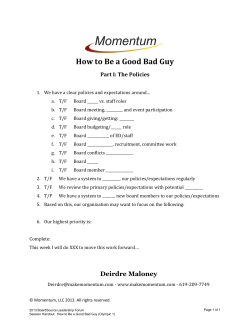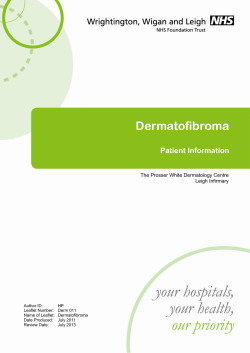
How to Fit Radionuclide Therapy Planning into Your Department Dr Matthew Guy
How to Fit Radionuclide Therapy Planning into Your Department Dr Matthew Guy Department of Medical Physics The Royal Surrey County Hospital Guildford matthew.guy@nhs.net matthew.guy@nhs.net Medical Physics,The Royal Surrey County Hospital Targeted Radionuclide Therapy • Aims – To deliver a tumourcidal dose to target volume – To minimise the dose to normal organs… • Rapidly increasing method of treatment for a wide range of cancers • Often given in conjunction with Chemotherapy or External Beam Therapy matthew.guy@nhs.net Medical Physics,The Royal Surrey County Hospital Combined TRT & XRT Planning Dose(Gy)45 Dose (Gy)60 0 0 Radionuclide Dose Map External Beam Dose Map • Maximum Dose: 45 Gy • Produced using RMDP (Radionuclide Multimodality Dosimetry Package) • Dose to Isocentre: 60 Gy • Parallel opposed pair Images Courtesy Rachel Bodey, The Royal Marsden, London matthew.guy@nhs.net Medical Physics,The Royal Surrey County Hospital Combined TRT & XRT Dose Map Images Courtesy Rachel Bodey, The Royal Marsden, London matthew.guy@nhs.net Medical Physics,The Royal Surrey County Hospital Targeted Radionuclide Therapy • Alpha, beta or Auger electron emitters can be used with these general requirements:– ~days < T1/2 < ~month – Low gamma and x-ray emissions (Imaging only) – Stable chemical bond to targeting agent • Why not utilise the High LET of a? – The a-recoil may break carrier-radionuclide bond, allowing daughter products (often unstable) to spread to normal tissue… – Targeting agent must bind very close to DNA (as is also the case with Auger electrons)… matthew.guy@nhs.net Medical Physics,The Royal Surrey County Hospital Targeted Radionuclide Therapy • Radioimmunotherapy (RIT) is the use of Monoclonal antibodies (Mabs) • Pressman demonstrated back in 1946 tumour targeting using antibodies Radionuclide 64 Cu 124 I 131 I 186 Re 73 Se 90 Y Primary photon energy /MeV Average beta energy /MeV 0.511 0.511 0.364 0.137 0.511 None 0.190 0.686, 0.974 (e+) 0.192 0.320 0.001, 0.562 (e+) 0.935 Half-life 12.7 hours 4.2 days 8.0 days 90.6 hours 7.2 hours 64.1 hours matthew.guy@nhs.net Medical Physics,The Royal Surrey County Hospital Current Therapy Range at RSCH • Ca Thyroid and Thyrotoxicosis – 131INaI (Amersham Health) • Bony Metastasis (~ Pain Palliation) – – 89Sr Cl2(Metastron - Amersham Health) 153Sm EDTMP (Quadramet - Schering) • Liver Metastasis – 90Y Microspheres (Sirtex) • Neuroblastoma, Phaeochromocytoma, Carcinoid – 131I mIBG (Amersham Health) matthew.guy@nhs.net Medical Physics,The Royal Surrey County Hospital 90Y Zevalin® • Non-Hodgkin’s Lymphoma (NHL) • Ibritumomab tiuxetan (Biogen IDEC - Schering) – CD20 antigen – found on the surface of normal and malignant B lymphocytes • FDA Approved February 2002 (initially) • European Approval imminent (before end 2003) • First radioimmunotherapy agent for cancer treatment – Response rates ~80% (when combined with Rituxan®) – Apparent Complete Response in ~20% – Schering market as “One Time Only” treatment… • Weight and platelet-based administration • Severe or life-threatening adverse events in <5% of patients: – allergic reaction – gastrointestinal hemorrhage – tumour pain matthew.guy@nhs.net Medical Physics,The Royal Surrey County Hospital Why Patient Specific Therapy? • Conventional administration is fixed or weight-based activity:– Q: – A: Treats an Average Patient? No: treats to ensure ~no high grade toxicity in patient group (subject to exclusion criteria) – Therefore, approach is safe: doses to organs at risk are kept low – However, (by definition) most patients are under treated • Benefits of tailoring therapies to individual patients are well documented over many years for External Beam Radiotherapy matthew.guy@nhs.net Medical Physics,The Royal Surrey County Hospital Patient Specific Therapy • Radionuclide therapy can be optimised by varying:– The activity administered – The frequency of therapies (“fractionation”) – The radioisotope used (a / ß ranges) • These approaches require planning along similar lines to Radiotherapy Planning (RTP) matthew.guy@nhs.net Medical Physics,The Royal Surrey County Hospital Patient Specific Input Required • Multiple wholebody activity measurements • Multiple NM datasets (preferably SPECT): – Must be quantitative (preferably absolute) – At least three sets per phase – Each dataset must be registered • Anatomical dataset (preferably CT) for use in: – Attenuation correction (iterative recon) – Localisation of disease – Registration of SPECT scans matthew.guy@nhs.net Medical Physics,The Royal Surrey County Hospital Sounds Like Hard Work… Arghh… matthew.guy@nhs.net Medical Physics,The Royal Surrey County Hospital Why Patient Specific Therapy? • The Law within the European Union… • Council Directive 97/43/Euratom 30/06/97 – Defines Radiotherapeutic as Pertaining to radiotherapy including Nuclear Medicine for therapeutic purposes –It states that For all radiotherapeutic purposes … exposures of target volumes shall be individually planned matthew.guy@nhs.net Medical Physics,The Royal Surrey County Hospital Medical Internal Radiation Dose 1 Define source organ (containing activity) and target organ (often the same) 2 Determine the cumulated activity in ~ the source organ - A ~ 3 Calculate the ‘S’ factor. Then D = A × S matthew.guy@nhs.net Medical Physics,The Royal Surrey County Hospital MIRD: The S Factor where 1 S= mt ∆ i × φi i m t = mass of target organ ∆i = φi = equilibrium dose constant for ith type radiation absorbed fraction for ith type radiation matthew.guy@nhs.net Medical Physics,The Royal Surrey County Hospital MIRD: Assumptions • Assumes uniform distribution • Results quoted only as a mean tumour dose • For all scans (input data) MIRD relies on – Volume determination – Localization • Difficulty with non-standard organ geometries (e.g. Tumours) matthew.guy@nhs.net Medical Physics,The Royal Surrey County Hospital The MIRD Approach • Despite limitations, MIRD offers fast results • Require a straight-forward spreadsheet and MIRDOSE 3.1(NB Not FDA Approved) • In most cases can be used for calculating: – Wholebody dose (VERY important; a Red Marrow) – Mean or Maximum dose to organs at risk (liver) • Not suitable for calculating TCP… matthew.guy@nhs.net Medical Physics,The Royal Surrey County Hospital MIRD Example Case • • • • Tracer 123I mIBG study on adult dosimetry patient Wholebody measurements made on 2m arc NaI SPECT studies acquired at 6, 26, 47 & 54 hours Calibration scans were carried out using activity distributions closely matching actual distribution • Predicted administered activities of 131I-mIBG to achieve preset wholebody doses are given • Therapy tumour and liver (main organ at risk) doses predicted for given wholebody dose matthew.guy@nhs.net Medical Physics,The Royal Surrey County Hospital MIRD Example: WB Retention matthew.guy@nhs.net Medical Physics,The Royal Surrey County Hospital MIRD Example: WB Levels 250 Percentage Error in I-131 Effective Half-life 2% 5% 10% T1/2:123I 200 150 15% 131I 100 50 0 0 2 4 6 8 10 12 14 I-123 Effective Half-life (hours) Weight Corrected Swb wb Maximum therapy WB dose is usually 2Gy matthew.guy@nhs.net Medical Physics,The Royal Surrey County Hospital MIRD: Calibration Scans • Must use the same camera as for the patient • Match scan parameters as closely as possible • The calibration scan is an admission that absolute 131I quantification is difficult to achieve… matthew.guy@nhs.net Medical Physics,The Royal Surrey County Hospital MIRD Example: Summary • Administration of 17.1 GBq 131I mIBG was predicted to give: – 2.0 Gy Wholebody dose (target maximum) – 11.4 Gy Maximum Liver dose (acceptable) – 15.4 Gy Maximum Estimated Tumour dose Patient was determined not suitable for therapy NB All calculations were independently checked on a separate system matthew.guy@nhs.net Medical Physics,The Royal Surrey County Hospital MIRD: Limitations • Recall, MIRD developed for diagnostic studies • Not really suitable for therapy studies • TCP (Tumour Control Probability) models show that the TCP of a tumour is heavily dependent on the TCP of its lowest voxel N TCP (D i ) = ∏ VCP (D i ) i =1 matthew.guy@nhs.net Medical Physics,The Royal Surrey County Hospital S value (mGy/MBq-s) 3mm Voxel S Factors Cube-to-cube Center-to-Center Distance (cm) Lionel Bouchet, University of Florida matthew.guy@nhs.net Medical Physics,The Royal Surrey County Hospital Dose Point Source Kernels • Dose Point Source Kernels (PSK) – Monte Carlo generated tables or plots of absorbed dose as a function of distance from a point source of activity • Convolve activity distribution with PSK to obtain absorbed dose distribution D= i.e. [A j × d (rj )] j The dose to each target voxel is the sum of the dose contributions from each source voxel matthew.guy@nhs.net Medical Physics,The Royal Surrey County Hospital Kernel Calculations Source voxel j contains activity Aj Distance rj Target voxel receives dose d(rj) from source voxel j matthew.guy@nhs.net Medical Physics,The Royal Surrey County Hospital Monte Carlo Calculations • PSK technique becomes difficult to implement in inhomogeneous media (ie areas of body) • Kwok (1990) – Dose to tissue within 2mm of tissue-bone interface underestimated by 20-40% due to backscatter • Furhang (1997) used CT registered with SPECT and PET to obtain density map matthew.guy@nhs.net Medical Physics,The Royal Surrey County Hospital Resource Implications • Wholebody data points – essential • SPECT data sets – minimum 3 / phase – Possibly 1 SPECT + 2 planar… (Koral et al JNM 44(3):457, 2003) • • • • Quantitative Reconstruction – incl CT Reg SPECT-SPECT Registration Patient Specific Dosimetry Interpretation and Reporting matthew.guy@nhs.net Medical Physics,The Royal Surrey County Hospital The Radioisotope Multimodality Dosimetry Package CT Data Raw Emission Data MRI Data IDL RMDP Quantitative 3-Dimensional Dose Maps IDL matthew.guy@nhs.net Medical Physics,The Royal Surrey County Hospital RMDP - Overview matthew.guy@nhs.net Medical Physics,The Royal Surrey County Hospital Inside the Box... • Key Components:- • Extras:– File Handling – Display – Interactive VOIs – Reconstruction – Registration – Dosimetry – Improved Quantitation for 2- & 3-D Images – List Mode Data – Monte-Carlo – Error Analysis matthew.guy@nhs.net Medical Physics,The Royal Surrey County Hospital File Handling Interfile Format DICOM Format Processing Interfile Format JPEG Format Raw Binary matthew.guy@nhs.net Medical Physics,The Royal Surrey County Hospital Display Options • All the usual suspects… – Transverse, Coronal, Saggital – Multi-slice – Cine – 3-D rendered view of activity / dose iso-surface • Imaging Tools – Profiles – Zooming and Resizing – Image Overlay / Linked Display matthew.guy@nhs.net Medical Physics,The Royal Surrey County Hospital VOIs & the Meaning of Dose Maps • Setting a VOI: – Manually drawn – Thresholded to a CT#/ activity/ dose level – Thresholded to a volume (e.g. CT / RT vol) • Interpreting a VOI: – Integral and Differential Dose Volume Histograms (DVH) matthew.guy@nhs.net Medical Physics,The Royal Surrey County Hospital I-131 SPECT Rendered isodose Absorbed dose CT + isodose contours matthew.guy@nhs.net Medical Physics,The Royal Surrey County Hospital 2-D Image Quantification • Developed for 186Re HEDP - (applicable to other isotopes)1: WB Images + Transmission Map (CT / Scaled Phantom) + Build-Up Factor Data = Quantitative Activity Map and Source Depth Map 1 Guy MJ et al J Nucl Med, 2001; 42: 822 matthew.guy@nhs.net Medical Physics,The Royal Surrey County Hospital 3-D Image Quantification • Processing Required to Quantify I-131… • Dead-time Correction • Scatter Correction • Attenuation Correction • PSF Correction • Image Reconstruction using FBP or OSEM1 Hudson HM, Larkin RS. IEEE TMI 1994; 13: 601-609 1 matthew.guy@nhs.net Medical Physics,The Royal Surrey County Hospital Dead-time Correction - Camera 1 matthew.guy@nhs.net Medical Physics,The Royal Surrey County Hospital Dead-time Correction - Camera 2 matthew.guy@nhs.net Medical Physics,The Royal Surrey County Hospital Scatter Correction • Conventional DEW and TEW available However... • The complex & high E gamma emissions of I-131 hamper conventional methods • Unlike Tc-99m / Tl-201, Patient Scatter no longer dominates… • List Mode acquisitions useful • Revisit with M-C later... matthew.guy@nhs.net Medical Physics,The Royal Surrey County Hospital Attenuation Correction • CT-based attenuation correction(FBP & OSEM) • Conventional Single Energy Scaling (120 or 140 kVp) • Single scan Dual Energy Transmission Estimation CT1 •µ at CT Eeffective must be scaled to Eemission •For H2O & soft tissue, factor is ~constant •But at low photon energies PE crosssection increases more rapidly for high effective Z materials, such as bone and use of a single scaling factor will cause errors •Bone error=58% - leads to an overall error of 9% for typical 99Tcm myocardial data 1 Guy MJ et al IEEE TNS 1998; 45: 1261-1267 matthew.guy@nhs.net Medical Physics,The Royal Surrey County Hospital The DETECT Process • Improves accuracy of high-energy attenuation maps without changing the clinical protocol Mean Attenuation Correction Error (%) 20 15 10 5 0 -5 120kVp (Conv.) 140kVp (Conv.) 140kVp (Dual Factor) DETECT (Cubic,No Corr) DETECT (Cubic, Incl Corr) DETECT (No Int, Incl Corr) Scaling Method matthew.guy@nhs.net Medical Physics,The Royal Surrey County Hospital Monte Carlo Simulation • 131-Iodine’s High Energy Gamma-rays… – ∴Problems with collimator penetration – Also problems with scatter in patient and imaging system µ (cm-1) 100 Attenuation Coefficient (cm ^-1) 1 µ (cm-1) Compton Scatter 0.1 10 Photoelectric Absorption 1 0.01 0 0.001 100 200 300 400 500 600 700 800 Rayleigh Scatter 0 200 300 400 Photoelectric Absorption 500 600 Rayleigh Scatter 0 .0 1 Energy (keV) Energy, E (keV) Photoelectric Absorption Compton Scatter Rayleigh Scatter NaI 700 800 Compton Scatter 0 .1 0.0001 Water 100 Energy, E (keV) E n er gy ( keV) matthew.guy@nhs.net Medical Physics,The Royal Surrey County Hospital Monte Carlo Simulation Improved Quantification 1 364 keV 503 keV 637 keV 643 keV 723 keV 0.9 0.8 Fraction of Photon Counts in Water 0.7 0.6 0.5 0.4 0.3 0.2 0.1 0 328-400(W1) 307-327(W2) 401 - 425(W3) Energy Window Range (keV) Analysing the interaction history of each photon and comparing the IMC data with that obtained from List Mode acquisitions should lead to improved image Quantification matthew.guy@nhs.net Medical Physics,The Royal Surrey County Hospital Dosimetry - Inputs • To generate pixel- or voxel-based dose maps, a Series of 2- or 3-D Quantified and Registered Data-Sets must be selected matthew.guy@nhs.net Medical Physics,The Royal Surrey County Hospital Dosimetry - Processing • Cumulative Activity Map: – Artifacts caused by image noise or mis-registration can be controlled by phase-fitting matthew.guy@nhs.net Medical Physics,The Royal Surrey County Hospital Dosimetry - Output • 3-D Cumulative Activity to 3-D Dose Map... – Voxel S-Factor or kernel (β only) calculation – All material assumed to be soft-tissue at present • 3-D Biological T1/2 maps can be produced • 3-D Error Maps based on T1/2 & fit analysis are also generated matthew.guy@nhs.net Medical Physics,The Royal Surrey County Hospital 131I Voxel Dosimetry - Case Study • A Quick Example… – Pediatric Ca Thyroid Patient – Unable to operate due to heart defect – Treatment History: • • • • • 10/00 04/01 06/01 10/01 02/02 NaI NaI NaI NaI NaI 400 MBq 400 MBq 1100 MBq 1100 MBq 1800 MBq (11 mCi) (11 mCi) (30 mCi) (30 mCi) (49 mCi) matthew.guy@nhs.net Medical Physics,The Royal Surrey County Hospital 131I Voxel Dosimetry - Case Study • Clinical Protocol requires WB+Static widespread metastatic disease • RMDP requires sequence of SPECT acquisitions matthew.guy@nhs.net Medical Physics,The Royal Surrey County Hospital 131I Voxel Dosimetry - Case Study • SPECT (covering neck, torso & abdo) acquired at 2, 18, 25, 42, 50, 68, 73 & 241 hours post admin. • Dead-time Correction Mid-plane Coronal slice through 2 hour SPECT data (OS-EM) • TEW Scatter Correction • CT-based µ Correction • OS-EM Reconstruction matthew.guy@nhs.net Medical Physics,The Royal Surrey County Hospital 131I Voxel Dosimetry - Case Study • Neck Dosimetry – Fast uptake (~60% of maximum within 2 hours) and long biological T1/2 lead to high dose around the thyroid bed and in the lymph nodes on the right-hand side matthew.guy@nhs.net Medical Physics,The Royal Surrey County Hospital 131I Voxel Dosimetry - Case Study • Lung Dosimetry – The long retention times (Effective T1/2 ~ 110hrs) for voxels in the left lung lead to high dose to the diseased lung matthew.guy@nhs.net Medical Physics,The Royal Surrey County Hospital 131I Voxel Dosimetry - Case Study • 3-D Error Analysis – 3-D Error Maps are generated with each Dose Map – Registration & Phase-fitting optimised using these maps – Eg Registration Optimised for Lungs, not Neck VOIs G.D. Flux et al PMB 2002;47:3211 & Cancer Biother Radpharm 2003;18:81 matthew.guy@nhs.net Medical Physics,The Royal Surrey County Hospital 90Y Dosimetry - Imaging ! • 90Y has no gamma emissions • 90Y Bremsstrahlung imaging is “challenging”… • MEGP +low (<150 keV) windowing probably offers “best” imaging characteristics on gamma camera ! " #$ % matthew.guy@nhs.net Medical Physics,The Royal Surrey County Hospital 90Y • • • • • Microspheres - Background 90Y SIR (Selective Internal Radiation)-Spheres® are designed for implantation into malignant liver tumours The spheres (20-40 m dia) become lodged in the small blood vessels of the tumour RSCH is involved in first wave of UK treatments Not curative - aim is to destroy sufficient tumour to render previously non-resectable disease suitable for surgery Administered activity is prescribed solely on the degree of tumour involvement in the liver (subject to negligible shunting to organs at risk) Research goals at RSCH for this study are to determine whether:•90Y SPECT of these patients is feasible, leading to post-therapy dosimetry •the distribution of a pre-therapy administration of 99Tcm MAA could be used to predict the distribution of SIR-Spheres® (so acting as a Tracer Study) matthew.guy@nhs.net Medical Physics,The Royal Surrey County Hospital 90Y Microspheres – Lung Shunting • ~ 3% of patients are expected to have significant (>10%) shunting to the lung and therefore be at risk from radiation pneumonitis • 100 MBq 99Tcm MAA was infused via a hepatic artery catheter under x-ray guidance • Planar gamma camera imaging, including TEW (with noise control) and taking Geometric Mean, was used to estimate degree of lung shunting • Up to 20% lung shunting is acceptable (though with reduced 90Y activity) matthew.guy@nhs.net Medical Physics,The Royal Surrey County Hospital 90Y Microspheres – Lung Shunting No Scatter Correction TEW Correction • Lung Shunt ~10.1% • Lung Shunt ~0.1% 20% 90Y reduction 0% 90Y reduction matthew.guy@nhs.net Medical Physics,The Royal Surrey County Hospital 90Y Microspheres - Administration ) ! *$+ # $ + # !% 3+! $ + % % $+ " ! # $% % & ' ( $ " ' , %% !$ # $% 4# /5 ! ! !$$ 5 -. # 6$+ # 5 ! ! !%2 0 # % % # !$$ #! % 1 + 2 +2 # + ! % % $ -. / + &!% '() * "+, " ) ! - , ! ,"$. matthew.guy@nhs.net Medical Physics,The Royal Surrey County Hospital 0 *$+ # Microspheres - 99Tcm + 90Y Imaging • Simulated combined SPECT imaging of 99Tcm MAA (150 MBq) & 90Y SIR-Sphere® (2000 MBq) • Corrected to remove Bremsstrahlung from images • Transverse, Coronal, Sagittal views from RMDP matthew.guy@nhs.net Medical Physics,The Royal Surrey County Hospital 90Y Microspheres - Dosimetry • As the spheres are permanently lodged in the liver and become immobile very quickly after administration, 3-D dosimetry is feasible with a single SPECT scan, • Avoids some of the resource implications of performing multiple SPECT scans on each patient (such as in 131I 3-D dosimetry) matthew.guy@nhs.net Medical Physics,The Royal Surrey County Hospital Discussion • TRT is resource (both staff & equipment) intensive, limiting its appeal & application • Software similar to RMDP is essential for performing substantial numbers of 3D plans – is able to collate, accurately process and analyse raw acquired data – releases valuable resources – provides research ‘platform’ (M-C, List-mode...) • Currently a lack of planning systems… matthew.guy@nhs.net Medical Physics,The Royal Surrey County Hospital Discussion • Some therapies are more favourable for patient specific dosimetry. For example: – 90Y Microspheres (immobile, single SPECT) – 186Re HEDP (skeletal, 2-D data satisfactory) • Lack of resources is the limiting factor in TRT dosimetry, not the physics • However, methodology is not established: – 3 centres calculate TCP 3 different results – Image Quantification is current weak link matthew.guy@nhs.net Medical Physics,The Royal Surrey County Hospital Discussion • Multi-centre studies probably offer best chance of resolving current dosimetry issues • Dose-response remains stubbornly elusive: – Poor input data (image quantification) – Poor dose model (beyond MIRD) – Poor understanding of Micro-dosimetry (what’s going on at the cellular level…) matthew.guy@nhs.net Medical Physics,The Royal Surrey County Hospital Thank you for your time! matthew.guy@nhs.net Medical Physics,The Royal Surrey County Hospital matthew.guy@nhs.net Medical Physics,The Royal Surrey County Hospital
© Copyright 2025









